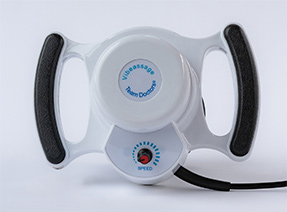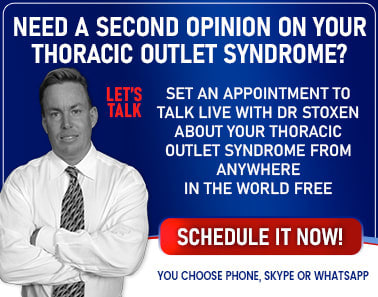When sleeping, it is necessary to maintain an equilibrium posture in the neck to avoid a sustained contraction, leading to compression of your joints. Equilibrium posture during sleeping is when there is an equal amount of tension of all neck muscles.
Pillows are intended to support the head and neck in a neutral position to minimize biomechanical stresses on cervical structures while sleeping. That is because they maintain the neck in a horizontal position to gravity.
One recent study investigated which pillow types produce different types and frequencies of waking symptoms in pain-free adults. Subjects were encouraged to test each trial pillow for a whole seven nights (completers), unless symptom production, or lack of sleep, necessitated cessation of its use.
The number of subjects having the lowest percentage of completers (67.3 percent) was the people who tested a feather pillow. The feather trial pillow performed least well, producing the highest frequency of waking symptoms. The latex pillow performed best, with 97 percent of the subjects who tested the latex pillow able to complete the seven-day trial. The foam contour pillow performed no better than the foam regular pillow.
The key to finding a pillow that will maintain an equilibrium posture in the neck is to test it in the store. Lie down with the pillow under your head and have someone take a photo horizontal to your spine to see if your head is level, angled above, or below horizontal.

The other thing that is important is for the pillow to maintain that thickness for as long as possible. When the pillow thins from use, your neck muscles will need to contract all night in an attempt to maintain your 9–12-pound head in the horizontal position.
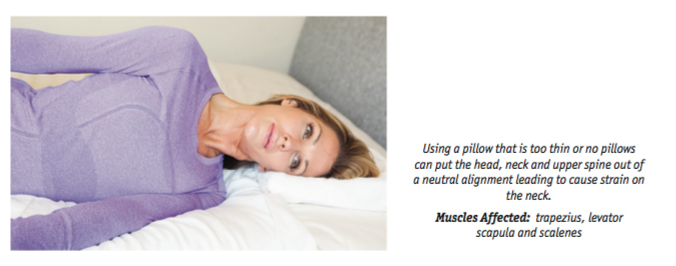

It is common to find many who develop the chronic habit of adopting an abnormal posture of keeping the arm above the head under the pillow. Poor posture while sitting or standing happens when you lean your body outside perpendicular to the pull of gravity.
Poor posture while sleeping happens when you lean your body or head outside of the perfectly horizontal posture to the pull of gravity. Poor sleeping posture can be a cause of thoracic outlet syndrome (1). Oftentimes, we have developed this habit to give a lift to the thinned-out pillow, so it maintains our head level, to avoid strain on the neck muscles.
For those of you who cannot break the habit of putting your arm under the pillow, you might want to try pinning the sleeve of your pajama arm to the pajama leg. You should sleep on the opposite side and avoid lying on your stomach. Pillows might be placed under each arm when lying on your back (2).
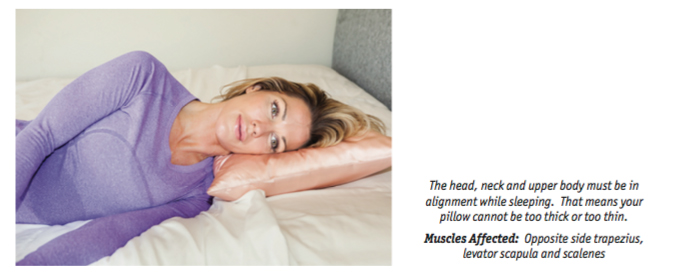
One thing that has helped me in those situations is to stuff the base of the pillow with a folded towel between the pillow and the pillowcase to thicken the pillow, so it is thick enough to maintain the horizontal position of the neck and the head.
This is an excerpt from a chapter in Dr Stoxen’s #1 best seller The Human Spring Approach to Thoracic Outlet Syndrome. The book is available on Amazon.com in these 13 counties US UK DE FR ES IT NL JP BR CA MX AU IN on Kindle. The book is available on Amazon.com in these 7 counties US UK DE FR ES IT JP in paperback.

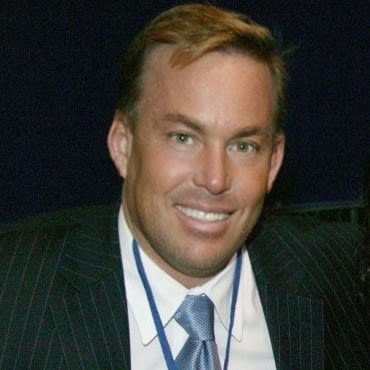
Dr James Stoxen DC., FSSEMM (hon) He is the president of Team Doctors®, Treatment and Training Center Chicago, one of the most recognized treatment centers in the world.
Dr Stoxen is a #1 International Bestselling Author of the book, The Human Spring Approach to Thoracic Outlet Syndrome. He has lectured at more than 20 medical conferences on his Human Spring Approach to Thoracic Outlet Syndrome and asked to publish his research on this approach to treating thoracic outlet syndrome in over 30 peer review medical journals.
He has been asked to submit his other research on the human spring approach to treatment, training and prevention in over 150 peer review medical journals. He serves as the Editor-in-Chief, Journal of Orthopedic Science and Research, Executive Editor or the Journal of Trauma and Acute Care, Chief Editor, Advances in Orthopedics and Sports Medicine Journal and editorial board for over 35 peer review medical journals.
He is a much sought-after speaker. He has given over 1000 live presentations and lectured at over 70 medical conferences to over 50,000 doctors in more than 20 countries. He has been invited to speak at over 300 medical conferences which includes invitations as the keynote speaker at over 50 medical conferences.
After his groundbreaking lecture on the Integrated Spring-Mass Model at the World Congress of Sports and Exercise Medicine he was presented with an Honorary Fellowship Award by a member of the royal family, the Sultan of Pahang, for his distinguished research and contributions to the advancement of Sports and Exercise Medicine on an International level. He was inducted into the National Fitness Hall of Fame in 2008 and the Personal Trainers Hall of Fame in 2012.
Dr Stoxen has a big reputation in the entertainment industry working as a doctor for over 150 tours of elite entertainers, caring for over 1000 top celebrity entertainers and their handlers. Anthony Field or the popular children’s entertainment group, The Wiggles, wrote a book, How I Got My Wiggle Back detailing his struggles with chronic pain and clinical depression he struggled with for years. Dr Stoxen is proud to be able to assist him.
Full Bio) Dr Stoxen can be reached directly at teamdoctors@aol.com








